HP Envy 14 Spectre Ultrabook Review: Something More Than Envy
by Dustin Sklavos on August 24, 2012 10:09 PM ESTApplication and Futuremark Performance
The HP Envy 14 Spectre is capable of enjoying the fastest ultra-low voltage processor on the market as well as employing Samsung's very respectable PM830 SATA 6Gbps SSDs, and the results are impressive. It may be heavy in the hand, but the Spectre is capable of being very nimble when stressed.
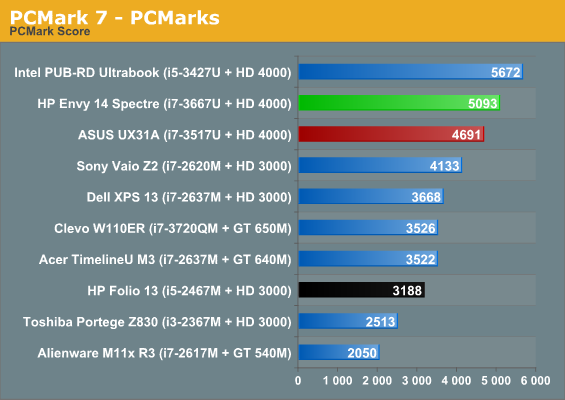
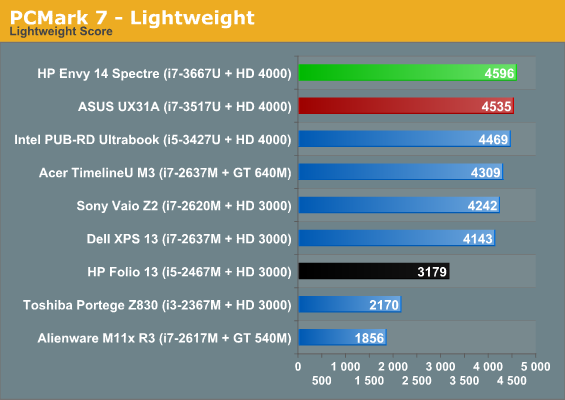

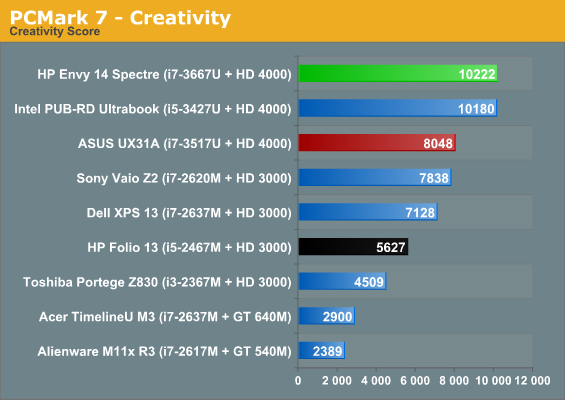
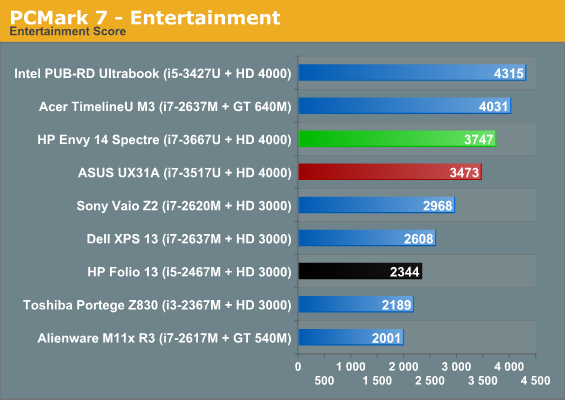
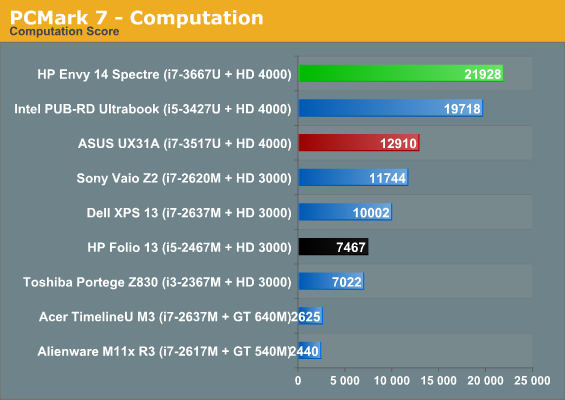
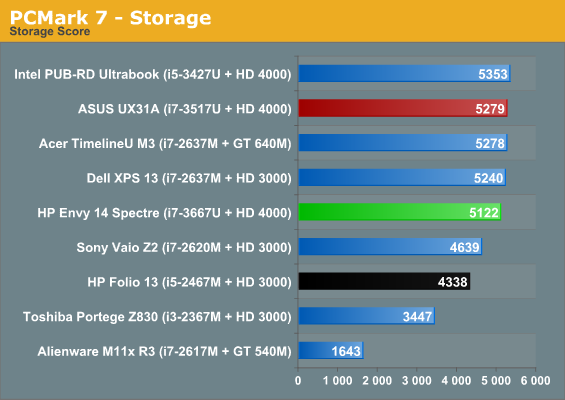

Between the SSD and fast ultra-low voltage processor, the Envy 14 Spectre ranks among the fastest ultrabooks we've tested and in many cases actually blows by the Sony Vaio Z2 and its full voltage Sandy Bridge processor. Note also that the Z2 employs a pair of SSDs in a RAID 0, so it's not terribly handicapped in this matchup.
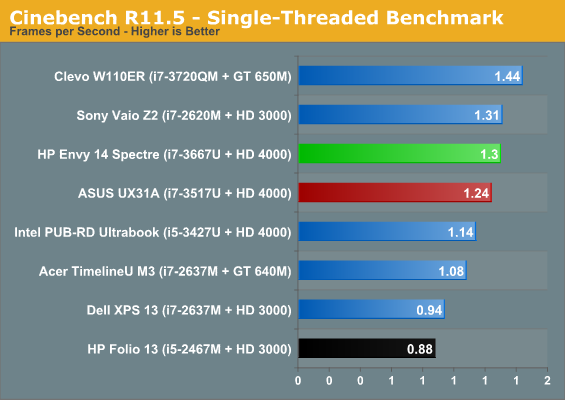
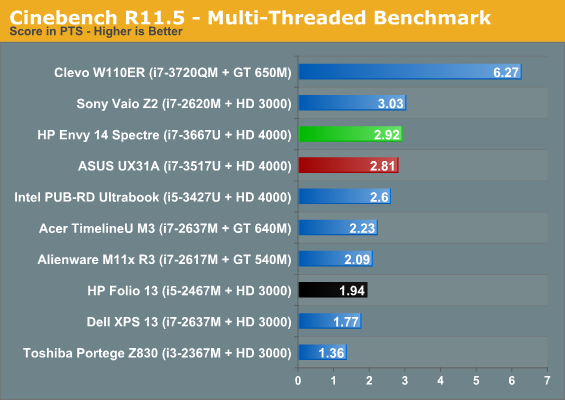
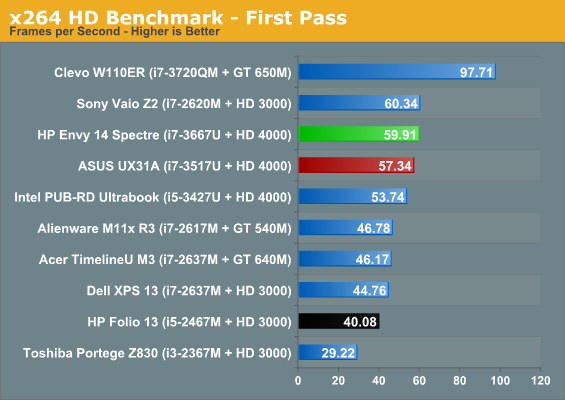
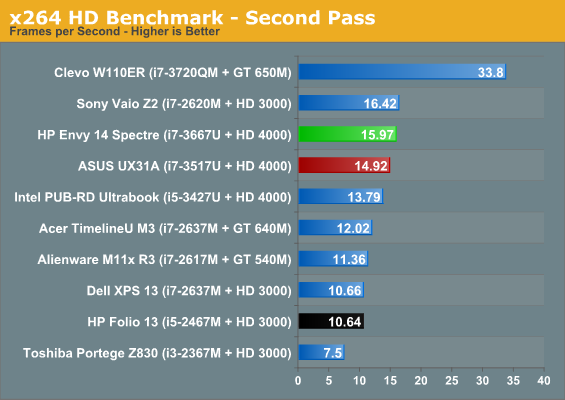
When we get to our CPU-limited benchmarks, the full scope of what Intel achieved with Ivy Bridge becomes evident: the i7-3667U is able to do in 17 watts what the last generation top end i7-2620M needed 35 watts to achieve. That's no small feat, and it's clear the Envy 14 Spectre isn't terribly hindered by its ultra-low voltage processor.
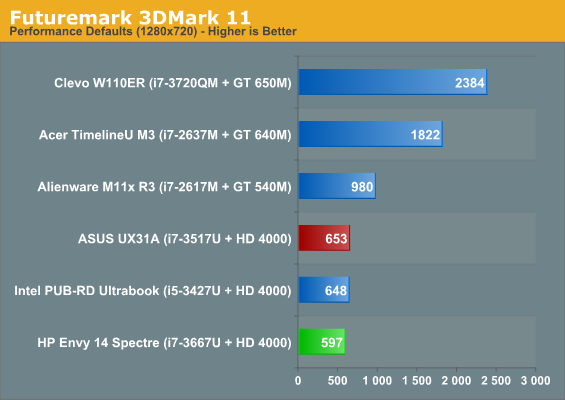
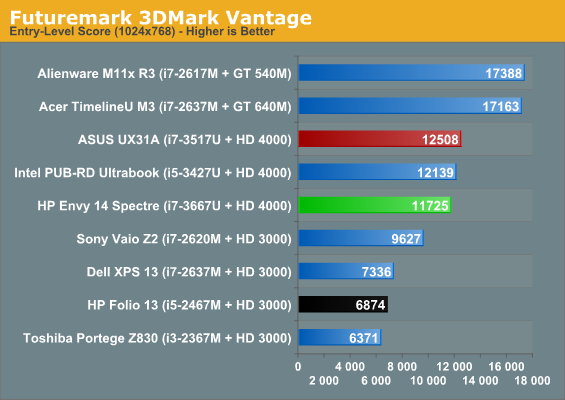
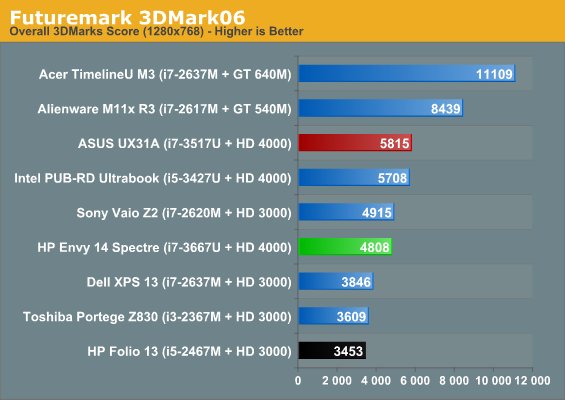
Unfortunately the 3DMarks are a bit less kind. Despite enjoying DDR3-1600, the single channel of memory bandwidth seems to noticeably hinder the HP Envy 14 Spectre. It's still baffling why HP went this route with both the Spectre and the Folio 13, but the results speak for themselves.










60 Comments
View All Comments
ImSpartacus - Saturday, August 25, 2012 - link
That's because good ultrabooks inherently demand "Mac prices."It's funny when PC OEMs try to make an Apple-like product and the price ends up similar to the Apple counterpart. When you stop shoving nice specs into a box, and actually care about the box, your BoM goes up. Keyboards, LCDs, and batteries aren't cheap.
There IS a markup on Apple products, but it's not as large as people think it is.
ananduser - Saturday, August 25, 2012 - link
It's selective. Markup is more evident on POS devices like the MBP 13".damianrobertjones - Saturday, August 25, 2012 - link
Apple were not the first to make a thin laptop or to use the chiclet type keyboardImSpartacus - Saturday, August 25, 2012 - link
But they did it best. Others have caught up since, but it took a while.ananduser - Saturday, August 25, 2012 - link
That's debatable.bobsmith1492 - Saturday, August 25, 2012 - link
"HP also includes a volume dial on the right side of the notebook, but I'm sorry to say this is not an analog volume dial. Oddly enough it seems to have its poles crossed, too; scrolling towards you turns volume up, while scrolling away turns it down."You can change the direction of the knob in the "Beats" control panel.
Voldenuit - Saturday, August 25, 2012 - link
It's a rectangle with rounded edges!Get them quick before Apple sues hp for patent infringement and gets an injunction to have them removed from the market...
Penti - Saturday, August 25, 2012 - link
They lost the iPad trade dress and design patent claims against the Galaxy Tab and Galaxy Tab 10.1 which don't infringe any of it so I'm sure a company that made slates back in 1992/3 and tablets back in last year with the same damn screen as iPad is fine today. They won on specific claims of the '381 patent claim 19, '915 patent claim 8 and '163 patent claim 50. Those include the patents who has been called after the features i.e. bounce back, one finger to scroll & pinch to zoom and lastly tap to zoom patents and only those patents where infringed when it comes to none design registration stuff. Which is weak to say the least. Several of the patents where issued after the products where released which would at least under US law mean you can't date back any damages before that point, but I have no idea how the jury came up with the numbers or why the judge thought it could be awarded damage that way.All the patents is essentially none-technical not forming any invention or use. Basically all stuff that according to EU law doesn't fit the criterion to be patented in the first place. No hard patents sure isn't a huge win. It's more ridiculous then Samsungs counterclaims. Also I'm not sure why a LG P970 would be scot free if SGS isn't. It's at least as much in similar shape and size i.e. visually as the SGS if not more so. Plus tablets if free when it comes to design claims and trade dress so there is no stopping. That this is all Apple has to fight with speaks to the fact that they got nothing and will loose the fight in the end. Samsung, LG, HTC, Nokia, Sony, Motorola, RIM etc got way more real and recognized patents in this field. If you put all that together I'm sure '915, '163 and '386 will get demolished plus they have no reason to care outside the US market where those patents isn't valid to begin with. While they might have patents stopping Apple products there instead. Apple and the competitors is just creating unnecessary work for themselves and only the lawyers are laughing.
Focher - Saturday, August 25, 2012 - link
LG devices weren't covered by the lawsuit because - well - they aren't Samsung devices.As for the judge and that damages calculation, the jury instructions - including the damages calculation - were negotiated between Apple and Samsung. The judge just approved them at the end.
It's true that the decision in the case doesn't apply outside the USA, but there's no doubt Samsung cares about the decision's impact on the US market.
Penti - Sunday, August 26, 2012 - link
I do blame both sides. I don't blame Samsung for their design though, side by side there is no mistake to be made while I'll dislike the cheaper Galaxy line and TouchWiz it has more to do with the divergence from standard theme and phone looks. On the higher end and updates to their software/theme it has certainly got better in both looks and performance.I do see it as a blow of course but it comes down on all players. For Samsung in the US though they are still free to sell SGS3, Galaxy Tab etc as those where not in the case or where freed on design claims if they just remove stuff like bounce back in the UI. Apple might think it's fine to get damages from patents that weren't issued at the time but in the end it will hurt them too. If the trade dress holds up on the phones though they would have no problem going after everybody else in other lawsuits. It's not like these features is worth the amount Apple is claiming even if it where real stuff plus when it comes to Apple overseas is still their biggest market. The claim that Google knew that this would happen because "Samsung was copying them" and warned them is also bogus when Nexus products where also effected (not by design patents though) and Nexus 7 looks way more like a small iPad then Galaxy Tab ever has.
Nexus S (4G) deemed infringe on two of the utility patents ('381, '915) was awarded 1,828,297 USD and freed on '163, that is for the Sprint Nexus S phone. Nexus S the original version it self was launched before '163 where issued. Nexus One for example where launched before both '163 and '915 where issued. Hardly much to come with, a change in the gesture features would make those products ok which just mean it's ok to have the bounce back effect in Canada but not over the border. Doesn't give much credence to Apples claim of 30-100 dollar per devices for licensing 2-3 patents either. If they where prepared to license it at some point why not force them today? It would be like 1 dollar per device. Max. As you could obviously get away from the iPhone trade dress despite having an all glass front and rounded corners. Not sure why they would go after SGS2 and not Nexus S though on design claims. Any way they are quite desperate when they claim a Sony Tablet S is an example of an design which don't infringe their design and trade dress which they lost against Samsung when their argument was that it was just with rounded corners on one side of the device. It looks way more similar then the Galaxy Tab series despite that. http://www.flickr.com/photos/virgile-fontaine/6169...
Let's see what happens to those old products, newer ones generally differentiates more in shape and sizes thanks to them being built around larger displays. Might be a heavy fine, and mean more ridiculous lawsuits, but products will still be there. It basically all resolves around a none-technical patent on UI, judged by an jury which you could circumvent by using alternative methods. I'm not to concerned about trade dress claims, basically only the original iPhone design patent and iPhone 3G design where protectable not combinations. It's laughable that Galaxy Ace where freed on all accounts concerning design and awarded no damages while SGS and SGS2 where found infringing. It's otherwise what I would say the most similar looking device. Size, shape, style all off it. It's off putting, but apparently ok.